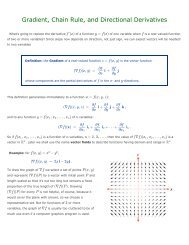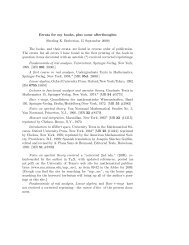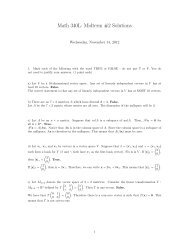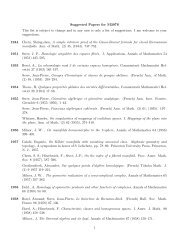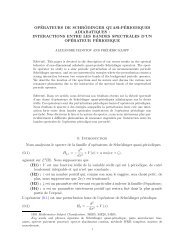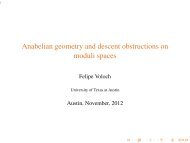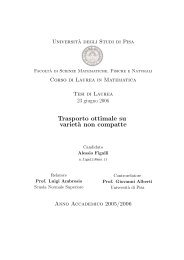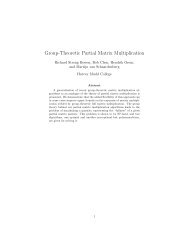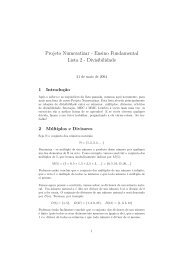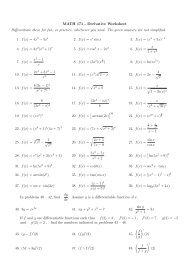Optimal transport, Euler equations, Mather and DiPerna-Lions theories
Optimal transport, Euler equations, Mather and DiPerna-Lions theories
Optimal transport, Euler equations, Mather and DiPerna-Lions theories
Create successful ePaper yourself
Turn your PDF publications into a flip-book with our unique Google optimized e-Paper software.
1.3. SUB-RIEMANNIAN MANIFOLDS 13<br />
Theorem 1.2.3 If Ric ≥ 0 <strong>and</strong> A satisfies (1.2.1), then U is displacement convex.<br />
In the above case, we have considered functional defined only on probability measures which<br />
are absolutely continuous with respect to vol. The big advantage of this fact is that, in this<br />
case, the curve µt we defined above is the unique Wasserstein geodesic between µ <strong>and</strong> ν. On<br />
the other h<strong>and</strong>, if we do not make any absolute continuity assuptions, the Wasserstein geodesic<br />
(which always exists) is in general not unique. One can therefore introduce two different notions<br />
of dispacement convexity, a strong <strong>and</strong> a weak one: the strong notion consists in asking that a<br />
functional defined in the space of probability measure on M is convex among all Wasserstein<br />
geodesics connecting two measures µ <strong>and</strong> ν; the weak one is that, for all µ <strong>and</strong> ν, there is some<br />
Wasserstein geodesic connecting them along which the functional is convex. The importance<br />
of introducing a weaker notion comes from the fact that it is more stable under passage to the<br />
limit, <strong>and</strong> so it is particularly suitable when one wants to recast lower bounds on the Ricci<br />
curvature tensor in terms of displacement convexity properties of certain nonlinear functionals<br />
[59, 73, 74]. However, as shown in collaboration with Cédric Villani, on Riemannian manifolds<br />
these notions are equivalent [24].<br />
1.3 Sub-Riemannian manifolds<br />
A sub-Riemannian manifold is given by a triple (M, ∆, g) where M denotes a smooth complete<br />
connected manifold of dimension n, ∆ is a smooth nonholonomic distribution of rank m < n on<br />
M, <strong>and</strong> g is a Riemannian metric on M. We recall that a smooth distribution of rank m on M<br />
is a rank m subbundle of T M. This means that, for every x ∈ M, there exist a neighborhood<br />
Vx of x in M, <strong>and</strong> a m-tuple (f x 1 , . . . , f x m) of smooth vector fields on Vx, linearly independent on<br />
Vx, such that<br />
∆(z) = Span {f x 1 (z), . . . , f x m(z)} ∀z ∈ Vx.<br />
One says that the m-tuple of vector fields (f x 1 , . . . , f x m) represents locally the distribution ∆.<br />
We assume that the distribution ∆ is nonholonomic, i.e. for every x ∈ M there is a m-tuple<br />
(f x 1 , . . . , f x m) of smooth vector fields on Vx which represents locally the distribution <strong>and</strong> such<br />
that<br />
Lie {f x 1 , . . . , f x m} (z) = TzM ∀z ∈ Vx,<br />
that is, such that the Lie algebra 2 spanned by f x 1 , . . . , f x m, is equal to the whole tangent space<br />
TzM at every point z ∈ Vx. This Lie algebra property is often called Hörm<strong>and</strong>er’s condition.<br />
A curve γ : [0, 1] → M is called a horizontal path with respect to ∆ if it belongs to<br />
W 1,2 ([0, 1], M) <strong>and</strong> satisfies<br />
˙γ(t) ∈ ∆(γ(t)) for a.e. t ∈ [0, 1].<br />
2 We recall that, for any family F of smooth vector fields on M, the Lie algebra of vector fields generated by<br />
F, denoted by Lie(F), is the smallest vector space S satisfying<br />
where [X, Y ] is the Lie bracket of X <strong>and</strong> Y .<br />
[X, Y ] ⊂ S ∀X ∈ F, ∀Y ∈ S,



